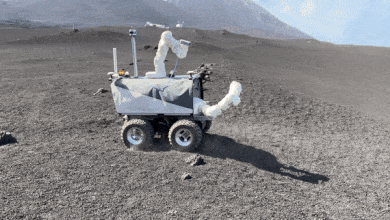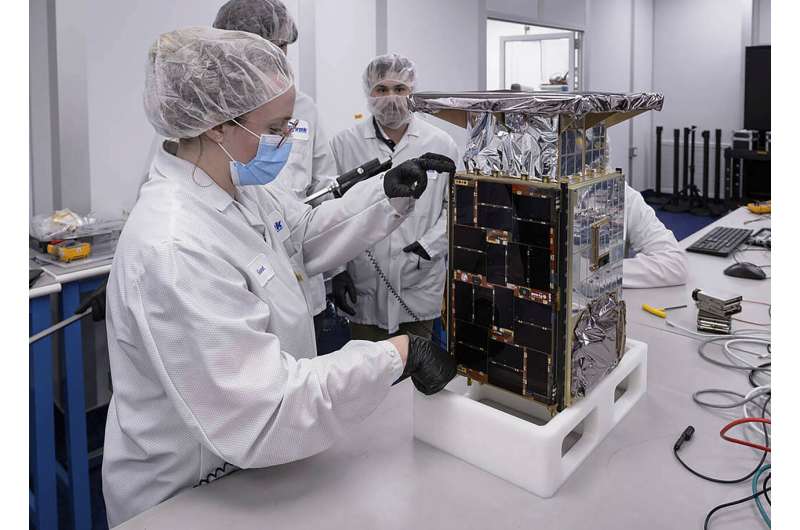L3Harris makes strategic investment in Mynaric
Wednesday, 06 July 2022 10:04
L3Harris is making a strategic investment in laser communications company Mynaric with plans to make increased use of that technology for space and other applications.
The post L3Harris makes strategic investment in Mynaric appeared first on SpaceNews.
Keeping the energy in the room
Wednesday, 06 July 2022 08:34 It may seem like technology advances year after year, as if by magic. But behind every incremental improvement and breakthrough revolution is a team of scientists and engineers hard at work.
UC Santa Barbara Professor Ben Mazin is developing precision optical sensors for telescopes and observatories. In a paper published in Physical Review Letters, he and his team improved the spectra reso
It may seem like technology advances year after year, as if by magic. But behind every incremental improvement and breakthrough revolution is a team of scientists and engineers hard at work.
UC Santa Barbara Professor Ben Mazin is developing precision optical sensors for telescopes and observatories. In a paper published in Physical Review Letters, he and his team improved the spectra reso Field Tests Help Prepare NASA Tech for Fire Season
Wednesday, 06 July 2022 08:34 Even before the summer's hottest, driest weather has arrived, wildfires have taken a heavy toll in some parts of the U.S. This spring, in collaboration with fire response teams, NASA researchers tested their prototype tools to help make the demanding job of wildland firefighters safer.
One element of the solution developed by NASA's Scalable Traffic Management for Emergency Response Operat
Even before the summer's hottest, driest weather has arrived, wildfires have taken a heavy toll in some parts of the U.S. This spring, in collaboration with fire response teams, NASA researchers tested their prototype tools to help make the demanding job of wildland firefighters safer.
One element of the solution developed by NASA's Scalable Traffic Management for Emergency Response Operat Cataloging the diverse origins of Earth's minerals
Wednesday, 06 July 2022 08:34 A 15-year study led by the Carnegie Institution for Science details the origins and diversity of every known mineral on Earth, a landmark body of work that will help reconstruct the history of life on Earth, guide the search for new minerals and ore deposits, predict possible characteristics of future life, and aid the search for habitable planets and extraterrestrial life.
In twin papers
A 15-year study led by the Carnegie Institution for Science details the origins and diversity of every known mineral on Earth, a landmark body of work that will help reconstruct the history of life on Earth, guide the search for new minerals and ore deposits, predict possible characteristics of future life, and aid the search for habitable planets and extraterrestrial life.
In twin papers Large Hadron Collider project discovers three new exotic particles
Wednesday, 06 July 2022 08:34 The Large Hadron Collider beauty (LHCb) collaboration has announced the discovery of three new exotic particles. Exotic particles, such as these, had only been theorised but not observed until recently. These exotic particles are built out of quarks.
"Like proton or neutrons, the particles that make up the nucleus of the atom, these new particles are made up of quarks", explained Chris Par
The Large Hadron Collider beauty (LHCb) collaboration has announced the discovery of three new exotic particles. Exotic particles, such as these, had only been theorised but not observed until recently. These exotic particles are built out of quarks.
"Like proton or neutrons, the particles that make up the nucleus of the atom, these new particles are made up of quarks", explained Chris Par New launch vehicles set for test flights from China’s Jiuquan spaceport
Wednesday, 06 July 2022 08:18
Newly-developed orbital and suborbital launch vehicles are being readied for test flights at the Jiuquan spaceport as China’s efforts to foster a commercial space sector advance.
The post New launch vehicles set for test flights from China’s Jiuquan spaceport appeared first on SpaceNews.
Rover plus astronaut complete Mount Etna challenge
Wednesday, 06 July 2022 06:12
In a complex role-played version of a mission to the Moon, controllers at ESOC combined with a team of geological scientists and ESA astronaut Thomas Reiter to oversee a rover’s collection of rock samples. Acting as if he were in lunar orbit, the astronaut was in fact based in a hotel room in Catania, Sicily, with the rover 23 km away and 2 600 m uphill on the volcanic flanks of Mount Etna. As Thomas commanded the rover to pick up rocks his hand experienced just what the robot’s gripper felt – an added dimension in remote
Update on CAPSTONE communications issue
Tuesday, 05 July 2022 23:32 Following successful deployment and start of spacecraft commissioning on July 4, the Cislunar Autonomous Positioning System Technology Operations and Navigation Experiment (CAPSTONE) spacecraft experienced communications issues while in contact with the Deep Space Network.
The spacecraft team currently is working to understand the cause and re-establish contact. The team has good trajector
Following successful deployment and start of spacecraft commissioning on July 4, the Cislunar Autonomous Positioning System Technology Operations and Navigation Experiment (CAPSTONE) spacecraft experienced communications issues while in contact with the Deep Space Network.
The spacecraft team currently is working to understand the cause and re-establish contact. The team has good trajector Star with the shortest orbital period around black hole discovered
Tuesday, 05 July 2022 23:32 Researchers at the University of Cologne and Masaryk University in Brno (Czech Republic) have discovered the fastest known star, which travels around a black hole in record time. The star, S4716, orbits Sagittarius A*, the black hole in the centre of our Milky Way, in four years and reaches a speed of around 8000 kilometres per second. S4716 comes as close as 100 AU (astronomical unit) to the bl
Researchers at the University of Cologne and Masaryk University in Brno (Czech Republic) have discovered the fastest known star, which travels around a black hole in record time. The star, S4716, orbits Sagittarius A*, the black hole in the centre of our Milky Way, in four years and reaches a speed of around 8000 kilometres per second. S4716 comes as close as 100 AU (astronomical unit) to the bl A new method for predicting the 11-year solar cycle strength
Tuesday, 05 July 2022 23:32 The Sun is our superstar, continuously providing our planet with energy, light, and heat, thus making it a very habitable environment for life. However, it is also the source of powerful explosions, which can affect astronauts and modern technologies in space and on Earth. At the beginning of the 17th century, Galileo Galilei dared to direct his telescope to the Sun and discovered sunspots there
The Sun is our superstar, continuously providing our planet with energy, light, and heat, thus making it a very habitable environment for life. However, it is also the source of powerful explosions, which can affect astronauts and modern technologies in space and on Earth. At the beginning of the 17th century, Galileo Galilei dared to direct his telescope to the Sun and discovered sunspots there The futuristic South Pole Telescope looks far back in time
Tuesday, 05 July 2022 23:32 Surveying the cosmos from its isolated position in Antarctica, a collaborative project aims to reveal insights about the universe's beginnings.
In summer at the South Pole, which lasts from November through February, the average temperature is a biting minus 18 degrees F. The sun does not set during this time, making sleep a challenge. The environment is harsh and dry. And the Internet connecti
Surveying the cosmos from its isolated position in Antarctica, a collaborative project aims to reveal insights about the universe's beginnings.
In summer at the South Pole, which lasts from November through February, the average temperature is a biting minus 18 degrees F. The sun does not set during this time, making sleep a challenge. The environment is harsh and dry. And the Internet connecti Sidus Space marks successful space-qualification of Dhruva space's satellite orbital deployer
Tuesday, 05 July 2022 23:32 Sidus Space, Inc. (NASDAQ:SIDU), a Space-as-a-Service company focused on mission critical hardware manufacturing; multi-disciplinary engineering services; satellite design, production, launch planning, mission operations; and in-orbit support is proud to announce that Dhruva Space's Satellite Orbital Deployer successfully achieved space-qualification on June 30.
Dhruva Space's Satellite Or
Sidus Space, Inc. (NASDAQ:SIDU), a Space-as-a-Service company focused on mission critical hardware manufacturing; multi-disciplinary engineering services; satellite design, production, launch planning, mission operations; and in-orbit support is proud to announce that Dhruva Space's Satellite Orbital Deployer successfully achieved space-qualification on June 30.
Dhruva Space's Satellite Or SatixFy Technology enables first 5G link through a LEO constellation
Tuesday, 05 July 2022 23:32 SatixFy Communications Ltd has announced its critical role in enabling the first ever demonstration of a high-speed, low-latency link with a LEO satellite constellation incorporating 5G.
SatixFy has partnered with OneWeb under the ESA Sunrise Partnership Project, with support from the UK Space Agency, to develop a compact electronically steered multi-beam array suitable for mobility servic
SatixFy Communications Ltd has announced its critical role in enabling the first ever demonstration of a high-speed, low-latency link with a LEO satellite constellation incorporating 5G.
SatixFy has partnered with OneWeb under the ESA Sunrise Partnership Project, with support from the UK Space Agency, to develop a compact electronically steered multi-beam array suitable for mobility servic NASA's CAPSTONE lunar orbiter leaves Earth orbit
Tuesday, 05 July 2022 23:32 The CAPSTONE orbiter left the low Earth orbit on its way to the moon, NASA said in a statement.
The Cislunar Autonomous Positioning System Technology Operations and Navigation Experiment is attached to Rocket Lab's Photon upper stage, which maneuvered CAPSTONE into position for its journey to the moon.
The Photon engine gradually increased its orbit over six days to 810,000 miles
The CAPSTONE orbiter left the low Earth orbit on its way to the moon, NASA said in a statement.
The Cislunar Autonomous Positioning System Technology Operations and Navigation Experiment is attached to Rocket Lab's Photon upper stage, which maneuvered CAPSTONE into position for its journey to the moon.
The Photon engine gradually increased its orbit over six days to 810,000 miles NASA: Contact lost with spacecraft on way to test moon orbit
Tuesday, 05 July 2022 19:26

